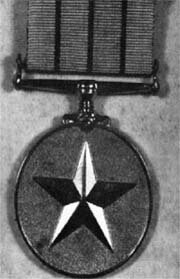
|
|
The award carries with it the right to use "V.S.M." as postnominal letters. The Vishisht Seva Medal was originally established as the "Vishisht Seva Medal, Class III" and only on 27 January 1967 was it renamed as detailed below. This did not, however, result in any change in the design of the medal and would be reflected only in the records. In 1980, the Yudh Seva Medal was created to recognize distinguished services in an opertional environment. Since that date, awards of the V.S.M. have been restricted to non-operational service. Established: 26 January 1960, by the President of India, as the "Vishisht Seva Medal, Class III." The statutes were revised on 30 April 1962 to clarify the fact that awards were made by the President of India (which had only been implied in the original statutes). The award was further revised and renamed on 27 January 1967. Obverse: A 35-mm circular medal, with a five-pointed star in the center. Suspended from a straight-bar suspender. Named on the edge. Reverse: The state emblem with the name of the decoration in Hindi above, "Vishisht Seva Medal" in Hindi. There was, of course, no alteration in this design with the changes which took place in the designs of the Param Vishisht Seva Medal and Ati Vishisht Seva Medal. Ribbon: 32 mm, yellow with three 2 mm dark blue stripes. Yellow 6.5 mm, dark blue 2 mm, yellow 6.5 mm, dark blue 2 mm, yellow 6.5 mm, dark blue 2 mm, yellow 6.5 mm. Awards: To understand the award better, a sample recipient would be the 19?? Award to Squadron-Leader Appasaheb Bhagwant Patil, Indian Air Force: "He led his squadron to carry out 3,000 hours of flying in less than a year in the difficult Assam Valley." Outline:
|

 The Vishsisht Seva Medal is awarded to recognize "distinguished service of an exceptional order" to all ranks of the armed forces. The award may be granted posthumously and subsequent awards are represented by a bar worn on the ribbon.
The Vishsisht Seva Medal is awarded to recognize "distinguished service of an exceptional order" to all ranks of the armed forces. The award may be granted posthumously and subsequent awards are represented by a bar worn on the ribbon.